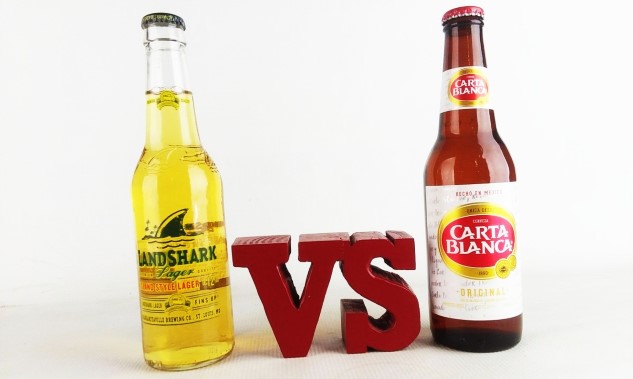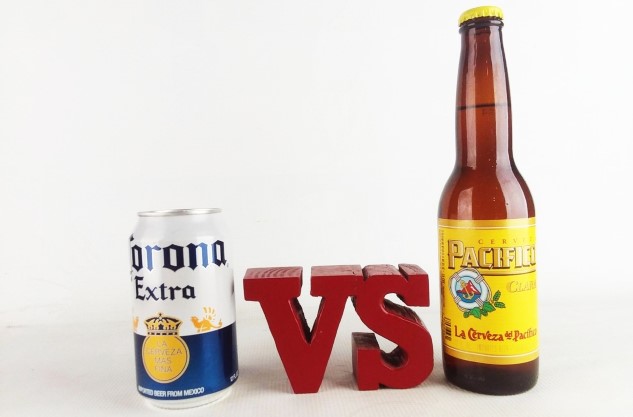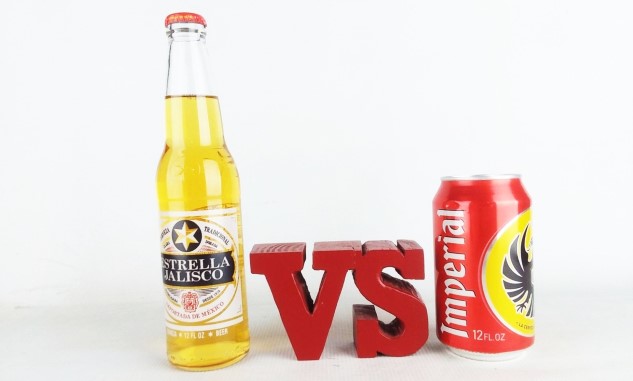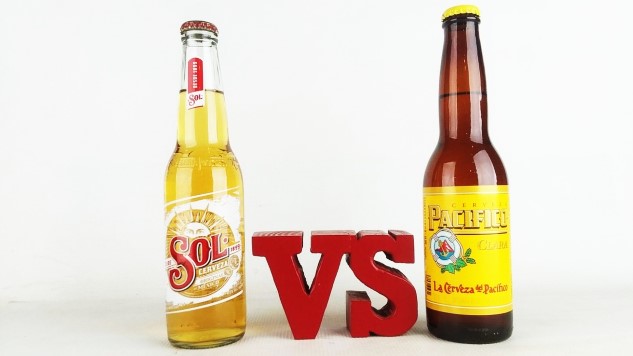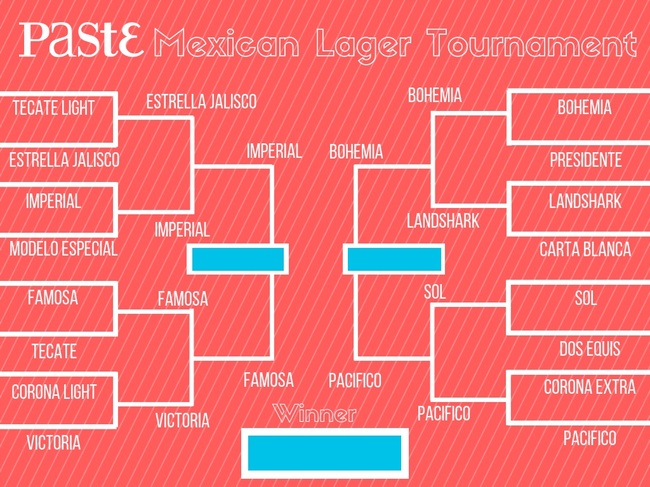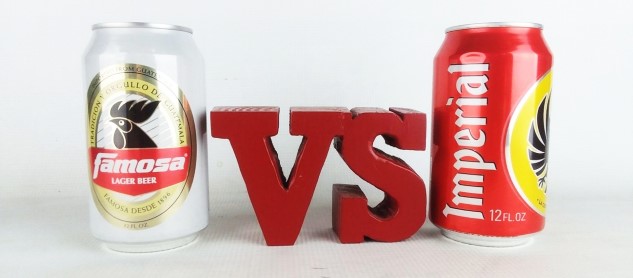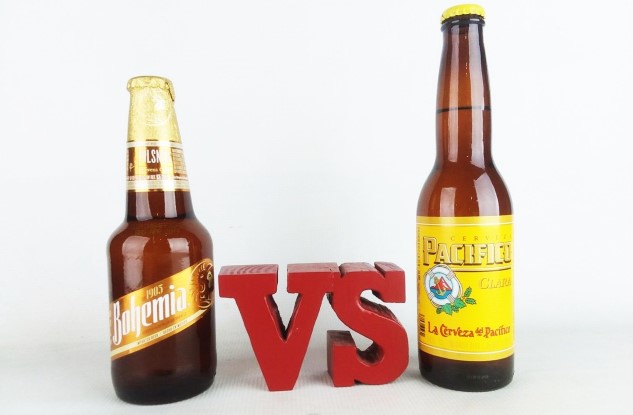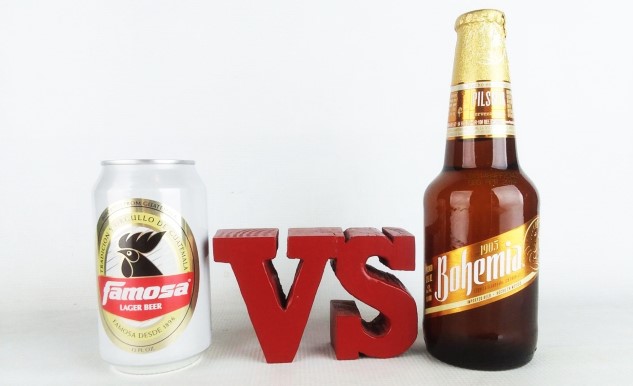The Great Paste “Mexican” Lager Tournament: 16 Beers, Blind-Tasted and Ranked
Photos by Jim Vorel
This list is part of a Paste series of bottom shelf liquor and craft beer style tastings. Click here to view all entries in the series.
There have been a lot of think-pieces written in the beer world in the last couple of years on why Mexican lager brands have continued their relentless growth in the U.S., and just as many reasons offered as factors. The U.S. of course has a rapidly growing Hispanic population, so some growth in Mexican and Central American beer brands would be only natural to expect, but the sheer rate of growth across the board has far outpaced anything that mere immigration could explain. In a time when the beer market as a whole is shrinking and the rate of craft beer growth is slowing, Mexican imports have only continued picking up steam, while being adopted by the younger segments of the U.S. beer-drinking population, regardless of ethnicity.
Look at some of these numbers for specific brands, and you get an idea:
— Pacifico sales in the U.S. grew 18.3% from 2016-2017
— Modelo Especial sales in the U.S. grew 17.3% from 2016-2017
— Tecate Light sales in the U.S. grew 22.9% from 2016-2017
These are pretty gaudy figures for established brands, and looking at them, it only makes sense that the mega corporations that own the majority of these brands are looking at their portfolios, asking themselves what other Mexican, Caribbean and Central American imports they can begin distributing in the U.S. The result has been a flood of new brands getting major pushes in U.S. distribution. You may have seen them as specials in restaurants or liquor stores, with brands differing by where you live, but any of the following names may now be familiar—Estrella Jalisco, Montejo, Indio, Sol and many more. To quote Beer Institute chief economist Michael Uhrich, in a Draft Magazine piece:
“Growth in the Hispanic population can’t be the only driver. Imports very clearly skew toward Millennials and Gen X, and obviously those generations’ share of the drinking-age population has been growing … so those two generations are more than half of all drinking-age Americans. As that continues, more and more people who drink beer are more and more likely to be people who drink Mexican imports.”
You want our own opinion on why these brands are appealing to Millennials and Gen X consumers? It’s honestly not that complicated—it ultimately comes down to a balance between familiarity and perceived authenticity. “Familiarity,” in the sense that ultimately, the truth of “Mexican lager” is that most of the mass-market examples (and biggest brands) are very, very similar to the “premium” macro lagers that U.S. consumers have been drinking all along. As much as the average U.S. consumer would like to believe they can tell a Bud Light apart from a Tecate Light, the two are in reality so close as to be indistinguishable to most palates, and this is absolutely by design. “Authenticity,” meanwhile, is that exotic quality imbued in import Mexican lager brands that make them an inherently hipper choice to order in a bar or bring to a BBQ, rather than yet another case of Bud or Miller Lite. Mexican lager represents a way to continue drinking something familiar while offering an illusion of exoticism and novelty. After all, light, refreshing lagers do have their place—it’s why we gathered 30 American macro lagers for a blind tasting earlier this year.
Which brings us to the big question: Which of the (increasingly varied) Mexican lagers available at your local package store or gas station is actually superior, from a blind tasting perspective? When you strip away the branding, who’s making the best cheap Mexican—or Central American—beer?
Typically, this is the kind of question that Paste likes to answer in our blind-tasting series, but Mexican lager felt like an opportunity to do something different. May we therefore present: The Great Paste “Mexican” Lager Tournament: A 16-seed tournament of Mexican, Caribbean and Central American light lagers.
A Note on Beer Acquisition
This Mexican lager tournament differs from pretty much any other Paste blind tasting in the sense that none of the beer was sent into the Paste offices in Atlanta by the breweries. Instead, we wanted to keep this field exclusively to macro, non-craft brands that a consumer might be able to find in an average package store. In fact, all 16 of the beers in this tasting ultimately came from a single Georgia liquor store, which is a distinction I don’t think we’ve ever been able to make before … and also a testament to how liquor stores are currently trying to stock every available Mexican lager under the sun.
Of course, when we say “Mexican lager,” we’re referring more to an archetype than anything. Not every beer in this entire tasting hails from Mexico proper. In order to fill out the lineup and bring the total number of beers to 16, we also accepted a few beers that compete in the same market, including one from the Dominican Republic, one from Costa Rica, and one from Guatemala.
We considered allowing craft Mexican lagers to enter this tournament side by side with their macro equivalents, but ultimately there are now so many craft-made Mexican lagers that simply choosing a handful for this tasting would have amounted to favoritism on our part. If anything, craft-made Mexican lagers deserve a blind tasting all their own, while leaving this tournament as a pure exploration of which readily available macro brands actually taste best.
Rules and Procedure
– This is a blind tasting of Mexican, Central American and Caribbean LIGHT lagers, and you won’t see any dark lagers here as a result. There are too many tastings of Mexican beer online that are dominated by the likes of Negra Modelo, which has an obviously unfair advantage as what is essentially a German dunkel lager competing against light adjunct lagers. A sole exception was made for Victoria, which is only slightly darker in color than the average Mexican lager.
– The beers were tasted blind over two days in the standard format of a 16-seed tournament, with the entire first round on the first day of tasting, and subsequent rounds on the second day.
– Tasters included professional beer writers, brewery owners and beer reps.
– Beers were judged completely blind by how enjoyable they were as individual experiences. Entries were judged by how much we enjoyed them for whatever reason, not by how well they fit any kind of preconceived style guidelines. As such, this is not a BJCP-style tasting.
![]()
Round 1: The Great Culling
The results of Round 1 were interesting in the sense that they were mostly unanimous—it wasn’t very difficult to determine the best beers in each of these rounds. Tasters generally agreed with one another about which offering was superior, and the wheat and chaff were separated pretty quickly, leaving several of the biggest brands in Mexican beer behind.
Here’s the opening bracket of the tournament, with first-round matchups in place. You can click for a larger version.
Now onto the matchups.
Tecate Light (Moctezuma) vs. Estrella Jalisco (AB InBev)

Estrella Jalisco is one of the latest Mexican lagers to get the Corona treatment, receiving a big marketing push in certain markets where AB InBev no doubt hopes it can be the next Mexican brand to find a foothold. Tecate Light, on the other hand, is just the lower-cal version of the venerable Tecate, and at 3.9% ABV is one of the lightest beers of the entire tasting.
Tasters found the Tecate Light fairly lightweight in the flavor department—very much in the mold of American-made adjunct light lagers. It’s slightly malty, with a wisp of biscuity malt but a flat, almost undercarbonated finish. An unpleasant, popcorn-like flavor lingers afterward—we were not fans of the experience.
Estrella Jalisco, meanwhile, is somewhat more assertive and certainly brighter than the Tecate Light. Slight corny sweetness is present here, and a touch of wheaty grain, along with a more unusual, almost vinous fruit character that is very subtle. Not the greatest, but more lively and bright than the Tecate Light.
Winner: Estrella Jalisco, by a decent margin.
Imperial (Cerveceria Costa Rica) vs. Modelo Especial (Grupo Modelo)

The non-Mexican lagers of this tournament were positioned against top-tier competition, but that didn’t stop several of them from really impressing us. Costa Rica’s Imperial drew a pretty tough round one matchup against Modelo Especial, which has become one of the fastest-growing Mexican lagers in the U.S. in the last few years.
Imperial was a very pleasant surprise for tasters, being very clean and light, but also not lacking character. Crisp, crackery malt blends nicely with some subtle, herbal/floral hop notes that get easier to pick up over time—this is one of the few beers in the tasting that you can accurately describe as “balanced.” Pleasantly refreshing, it drew high marks from all tasters, and the following comment: “If the style should be super clean, light and refreshing, this is that beer.”
Modelo Especial, by contrast, came across as a more assertive beer than Imperial, but was arguably lacking the former’s impeccable balance. Both maltier and slightly more fruity, with a faint solventy note and fuller mouthfeel, it wasn’t outright objectionable, but it couldn’t approach Imperial’s drinkability or pleasant hop notes. That was all we needed for a first round upset.
Winner: Imperial, for its balance.
Famosa (Cervecería Centro Americana, S.A.) vs. Tecate (Moctezuma)

Another beer that none of us had ever heard of before this tasting, and another shockingly tasty discovery. Seriously, has anyone out there even seen a can of Famosa before? This Guatemalan lager was initially included in the tournament as a way to reach the requisite 16, but it ended up completely upending our expectations. On the other side we have Tecate, a recently annointed hipster favorite with designs on becoming the Mexican equivalent of PBR.
Tecate tastes like classical adjunct lager, all the way, and that’s not really a bad thing. It’s crisp and has hints of corny sweetness, being fairly neutral overall, with “husky” notes of grain and a rounded mouthfeel. On the not-so-great side, it finishes with a slightly metallic tinge, but is still among the more drinkable of the “standard” Mexican lagers we sampled.
Famosa on the other hand, was totally and completely unique, in ways we sure as hell were not expecting. This ended up being arguably the most hoppy beer of the tournament, despite being labeled simply as lager (not “pilsner” or anything like that) and not bearing any indication on the can that it would be hop-forward. It was even more hoppy on first inspection than Bohemia, well-noted for usually being the most classically pilsner-like of the Mexican lagers. The character of Famosa, though, feels more Czech pils rather than German pils—it’s quite green and spicy, with Saaz-like flavors that are quite punchy and intriguing. This is backed up by several clone brew kits online, which all list Saaz as the operative aroma hop. Regardless, this beer proved far more fascinating than we were expecting.
Winner: Famosa, for just being far more interesting.
Corona Light (Grupo Modelo) vs. Victoria (Grupo Modelo)
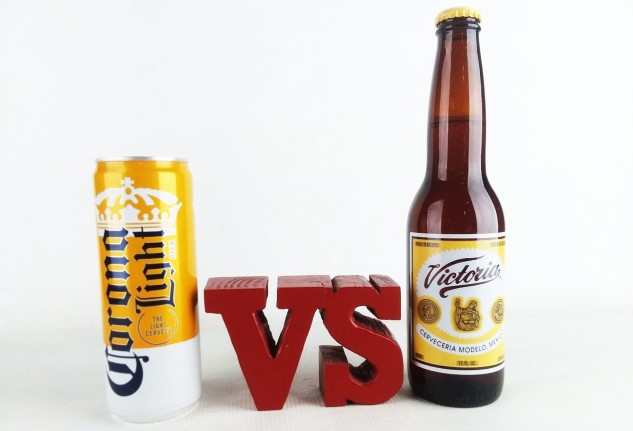
I don’t really need to introduce the likes of Corona Light, do I? It’s that beer your parents drink when they go to the beach. Victoria, on the other hand, is a Mexican lager with significant street cred among the craft beer community, increasingly appearing on the menus of upscale restaurants as a hip Mexican import alternative to domestic lagers. Of course they’re both made by the same company, so sneering at one while praising the other is a little pointless.
Nevertheless, Corona Light truly was an unpleasant experience in this first round. Sweet and oddly perfumey, one score sheet describes it as “smelling like a gas station,” which is rarely seen as a compliment in my experience. On repeated tastes, a wave of skunkiness comes forward—impressive, given that this was canned Corona Light, rather than bottled. This was just bad all around.
Victoria, on the other hand, stands out here not just for its slightly darker color—you can try to call it a Vienna lager, but it’s more like an adjunct lager with a bit of coloration—but also for its relative subtlety. At only 4% ABV, it’s actually slightly less alcoholic than Corona Light, and its ceiling in terms of flavor assertiveness is fairly low. Its signature flavor note is a small, subtle note of toasted bread crust, which works well with a very smooth, easygoing texture. Very drinkable and easy to enjoy.
Winner: Victoria, in a lopsided rout.
-

-

-

-

-

-

-

-

-

-

-

-

-

-

-

-

-

-

-

-

-

-

-

-

-

-

-

-

-

-

-

-

-

-

-

-

-

-

-

-



